Car detailing involves the thorough cleaning of the interior and exterior of your vehicle. It goes way further than a car wash, which often involves a slapdash cleaning of your car’s exterior and interior. Some detailing shops include minor paint correction and protection in their car detailing packages.
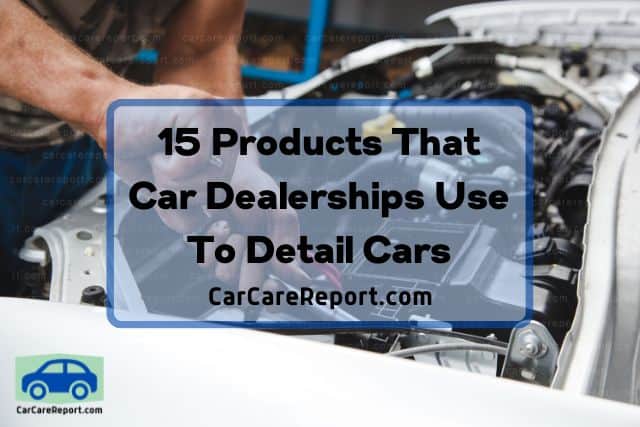
Car dealerships use the following 15 products to detail cars:
1. Soap
2. Waxes
3. Clay bars
4. Steamers
5. Foamers
6. Buffing pads
7. Vacuums
8. Exterior and interior brushes
9. Microfiber mitts and towels
10. Glass cleaners
11. Degreasers
12. All-purpose cleaners
13. Pressure washers
14. Air compressors
15. Tire soap and gel
Let’s examine these products to find out how car dealerships use detailing to restore and maintain cars to pristine condition.
1. Soap
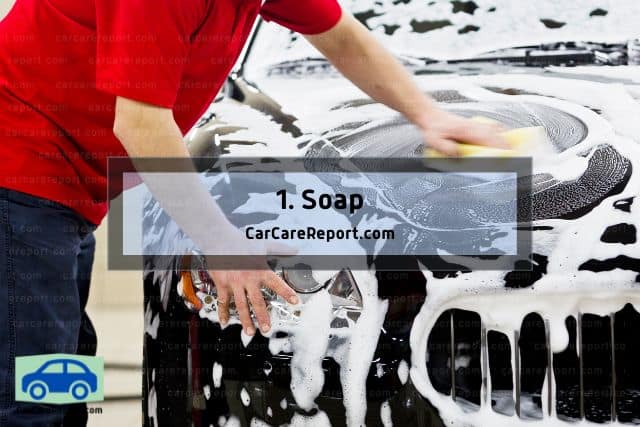
You will find soap in every detailing shop you enter. However, the soap used by car detailers isn’t the same soap you get in car washes.
Detailing soap has neutral pH – it has no acids that can destroy car paint. It’s often concentrated and comes with instructions on how to blend with water.
These soaps have excellent foaming ability, ensuring that every part of the car’s exterior gets enough soap. Some soap products have water streak and spot resistance, preventing the formation of ugly spots and streaks on the car during washing. They achieve this by including wax in their formulation, which slows evaporation.
Most soaps also sport a pleasant smell, making cleaning a bit more enjoyable.
2. Waxes
Car detailers use wax to protect and add shine to clean paint. Waxing is one of the final steps in the detailing process.
Waxes are generally split into two: natural wax and synthetic wax. Natural wax contains a substance called Carnauba extracted from a Brazilian palm tree while synthetic wax is made from polymers that adhere to the paint.
The quality and cost of natural wax increase with carnauba wax concentration. Natural waxes generally produce a deeper shine than synthetic waxes, but they are less durable.
Both come in paste, liquid, or spray form. Paste and liquid wax last longer and require more time and effort to apply than spray wax, often used by detailers to boost a wax layer that’s wearing off.
Car dealerships prefer synthetic waxes due to their durability and paint-protection capability. Spray waxes are also a favorite of dealerships due to their ease of application.
3. Clay Bars
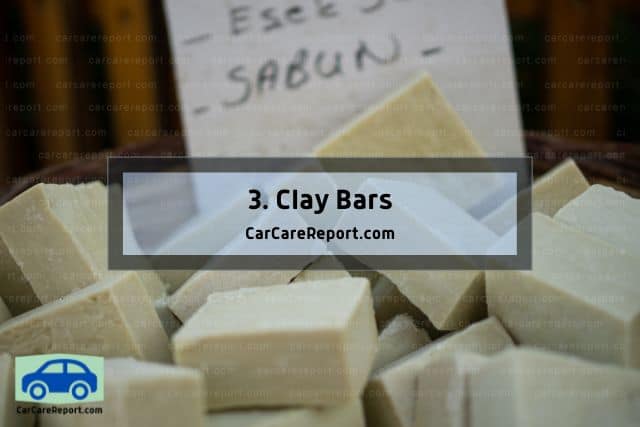
Even after thorough car washing, some contaminants remain on the surface of the paint. If the detailer fails to remove these contaminants, paint protection won’t achieve the required results.
Clay bars are elastic and abrasive products that remove contaminants washing failed to clear. It helps remove blemishes like brake dust and fine road grit from the car’s clear coat.
After the car dries, the detailer sprays clay lubricant on the vehicle to prevent clear coat damage when scrubbing. By gently cleaning the paint, the detailer is able to clear stubborn debris.
Cleaning a vehicle using a clay bar takes about half an hour. The contaminants stick on the abrasive clay bar, preparing the paint for protection.
Car dealerships use clay bars because they are quick, effective, and cheap cleaning tools.
4. Steamers
Steamers are the perfect tool for interior car detailing, especially for used car dealers.
Steam cleaning removes all kinds of dirt from nearly all types of surfaces. For instance, steam opens the pores in leather seats, pulling out the dirt and restoring them to near factory finish.
Using steamers eliminates the need for harsh chemicals and brushes inside the vehicle.
Another advantage of steam is its antibacterial properties. Steaming kills bacteria from the seats and steering wheel safely and sustainably.
Steamers are also effective as engine bay cleaners. The steam removes engine oil and lubricants quickly, leaving the engine spotless.
Furthermore, with less than one gallon of evaporating water, detailers can clean a car with negligible water wastage. Therefore, steamers make invaluable tools for car dealerships in areas with water restrictions.
5. Foamers
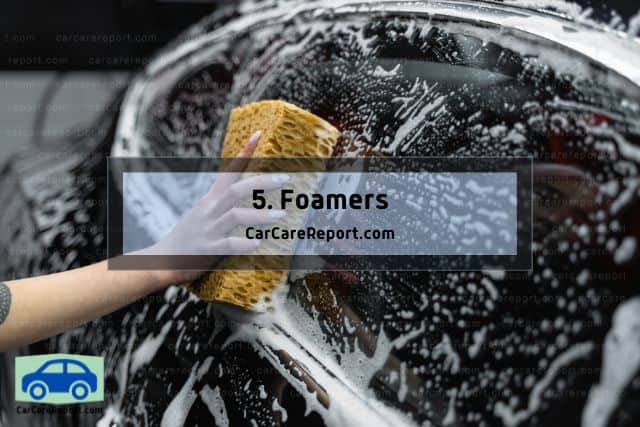
The traditional method of washing a vehicle can be effective. However, the high-tech world of car detailing prefers using foamers rather than wash mitts to apply soap to the vehicle.
A foamer or a foam cannon is a device used to spray soap solution to the car’s body. It coats the entire vehicle with a thick layer of soap solution, allowing the soap to work on the dirt.
With the car covered in soap, it’s easier for the detailer to wipe it off using a wash mitt. The soap provides enough lubrication, reducing the chances of scratching the car’s paint while agitating the dirt.
Using a foam cannon ensures that the detailer never runs out of soap while cleaning the vehicle. It also makes it easier to keep track of the cleaned areas.
6. Buffing Pads
Buffing is a paint correction method that removes scratches and blemishes from the car’s clear coat. While clay bars are effective at removing contaminants, they are powerless against scratches.
Buffing removes scratches by removing a microscopic clear coat layer. The detailer applies buffing compound on a pad and gently removes small layers of clear coat from the paint.
The pads and buffing compounds have varying degrees of abrasiveness depending on the type of scratches they are designed to remove.
You’ll likely find less abrasive pads in car dealerships than in detailing shops where major detailing jobs happen. Car dealerships often only need to rectify minor paint damage inflicted during transportation. Sometimes, they also use buffing pads to apply wax or polish to car surfaces due to their flexibility and absorbent properties.
7. Vacuums
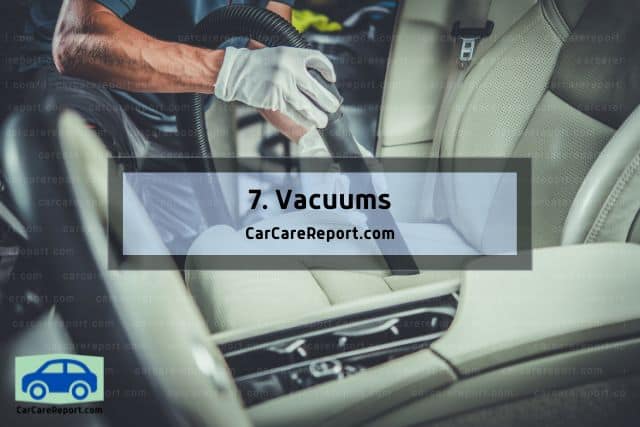
Vacuums are essential for car detailers, particularly because nearly everyone has a pet that enjoys car rides. Unfortunately, pets litter the car with fur that may not come out during a regular clean.
If you eat in your car, it’s conceivable that several crumbs may have fallen into hard-to-reach places where regular cleaning can’t reach. Moreover, some vehicles have carpeted floors that trap dust and spillages. Some car seats also sport fabric covers that trap dust and hold ugly stains whenever anything colored spills on them.
Car detailers eliminate all these contaminants – and at times, health risks – using vacuums. The machine sucks up debris from the car surfaces, cleaning and restoring them.
8. Exterior and Interior Brushes
Brushes are essential in the detailing process as they help clean areas where washing mitts and pressure hoses can’t reach.
For instance, a wheel brush helps the detailer scrub the rim meticulously, ensuring that dirt and debris get out of those hard-to-reach places. Some manufacturers build wheel brushes you can attach to a machine that spins the brush very quickly, saving the detailer the energy to agitate the dirt on the wheel.
On their part, interior brushes assist detailers working on areas where a large machine like a vacuum might not do a good job. For instance, a vacuum and steamer will get the dirt off a steering wheel but won’t leave it spotlessly clean.
A competent detailer will use an interior brush and soap to get the dirt off all the cracks and crevices the big machines couldn’t reach.
9. Microfiber Mitts and Towels
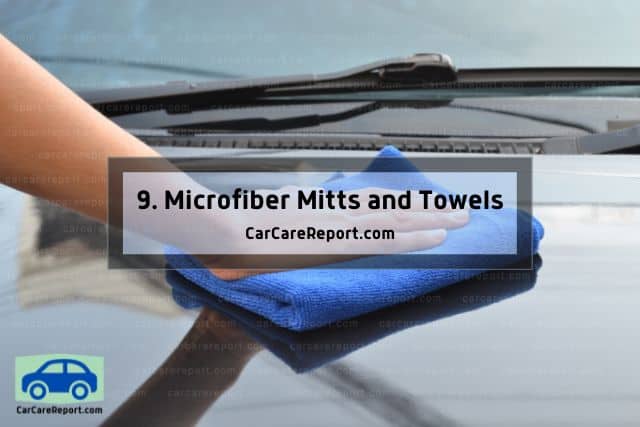
Microfiber mitts are doubtlessly the best materials for washing cars, explaining why you find them at most car dealerships.
Interestingly, many people mistakenly believe that sponges are the best materials for washing cars. Sponges work, but they tend to trap and move debris around, scratching the car or leaving swirl marks.
Conversely, mitts lift the dirt preventing it from scratching the paint as you move the mitt around. Furthermore, the strands of microfiber mitts create less friction, making it easier to collect the debris instead of sliding it on the car’s surface.
Detailers use microfiber towels to wipe vehicle surfaces as the material holds liquids instead of absorbing them. It facilitates reusability, saves the car dealership money, and prevents the buildup of bacteria on the towel.
Furthermore, microfiber towels are gentle on the car’s paint.
10. Glass Cleaners
A common mistake people make when cleaning cars at home is using window cleaner to clean vehicle windows. They end up with streaky windows and destroyed tint.
Detailers use specially formulated auto glass cleaners to clean the glass areas of your car. Glass cleaners coupled with microfiber towels produce the best results.
Professional car detailers usually clean the mirrors and windows last to prevent them from getting dirt from other areas of the car. They also dedicate several microfiber towels to glass cleaning to avoid contamination.
To prevent overspray, detailers spray glass cleaners over the cloth rather than on the glass surface.
11. Degreasers
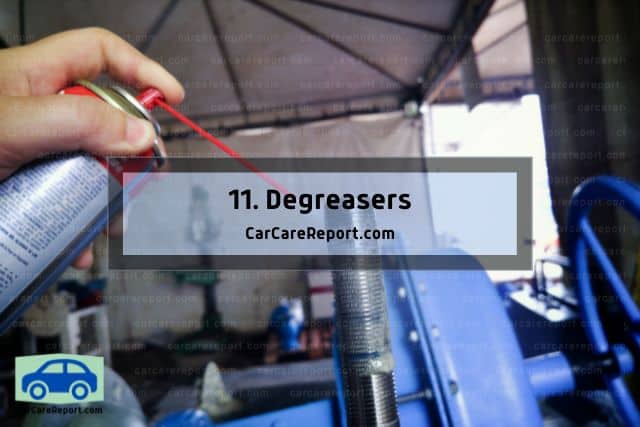
Detailers reach for degreasers to remove stubborn stains. They remove oils, grease, and dust from car surfaces.
This product is perfect for engine washing as it helps loosen fluids and oils that may have spilled on the engine bay. It is also very effective against brake dust which collects on the wheels and near the wheel arches.
Degreasers really prove their worth when detailers come against stubborn stains. For instance, tree sap or bird droppings that have dried onto the car’s surface are notoriously challenging to remove with a microfiber mitt and soap. Clay bars aren’t designed to remove such types of stains – the solution is a bit of degreaser and gentle agitation with a microfiber towel.
The convenience and effectiveness of degreasers make them a staple of every detail shop.
12. All-Purpose Cleaners
All-purpose cleaners clean all car surfaces, the interior and exterior. They are billed as miracle substances that work against all types of stains and dirt. Therefore, they are preferred by car enthusiasts who choose to use one product to complete the detailing job rather than pay a detailer to do the job for them.
Due to their convenience, you’ll find them in many car dealerships – why pay for many products if you can buy one that’ll clean all surfaces?
The issue with all-purpose cleaners is that users must follow manufacturer instructions to the letter to avoid disappointment. People complain about the ineffectiveness of car cleaners because they fail to follow instructions.
That said, most professional detailers use all-purpose cleaners as a backup rather than an everyday tool.
13. Pressure Washers
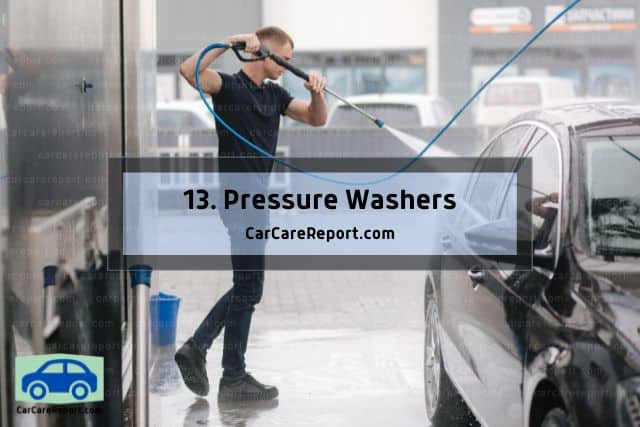
You will not find a detailing shop without a pressure washer. They are also present in most car washes.
CarCareReport dot com is owner of this article and was first posted on Sep 20, 2022 and was updated on ..
Pressure washers save time as they reduce the amount of scrubbing and rinsing a car detailer would need to do by hand. Furthermore, they help remove stubborn stains like mud, bugs, tar, and pollen.
Spraying the car with a pressure washer before foaming allows the soap to work better and faster, reducing the effort and time needed to agitate the dirt with a microfiber mitt.
14. Air Compressor
An air compressor basically blows compressed air anywhere the detailer points the nozzle. It’s a handy tool that many detailers now view as essential.
Air compressors remove dirt from areas where vacuums can’t reach, like cup holders and center consoles. They get into cracks and blow out dirt and debris.
To get the best results from vacuuming, detailers start by using an air compressor on the surfaces. It agitates the dirt, bringing it to the surface, where it’s easier for the vacuum to suck it in.
Air compressors also help remove water that gets lodged in cracks. Instead of letting the water dry and risking the formation of water spots, detailers use an air compressor to remove the water.
Compressed air also makes cleaning the engine bay easier. It removes loose particles like dirt, pollen, and leaves before the detailer starts working on the grease and oil.
Finally, air compressors also help remove debris from buffing pads, increasing the pads’ longevity.
15. Tire Soap and Gel
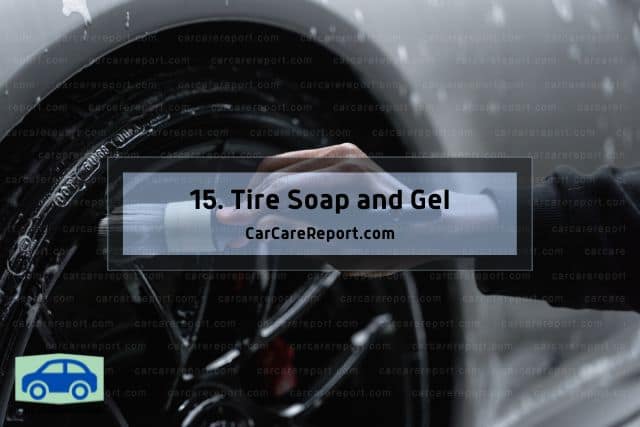
Tires go through a lot of torture, so they need special treatment. To remove dirt and prevent the accumulation of grime, manufacturers have formulated a special tire soap that cleans rubber.
Detailers spray the solution on the tire wall, agitate the dirt with a tire brush, then use a pressure washer to clear the dirt.
First published on Sep 20, 2022 by CarCareReport.com.
For the wheels to match the shiny car, detailers apply tire shine or gel to the tires. The gel or spray products give the wheels a high-gloss pop that makes them stand out.
Related Articles
Is Using a Clay Bar Worth It? The Facts Explained
How Much Does It Cost To Wax and Buff Your Car?
Buffing VS Waxing a Car: The Differences Explained
4 Important Differences Between Clay Bar Types
CarCareReport dot com first published this article on Sep 20, 2022..
